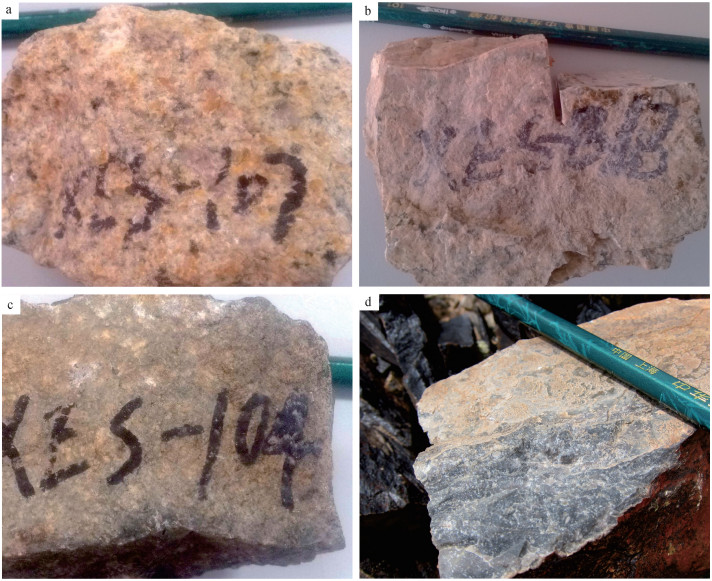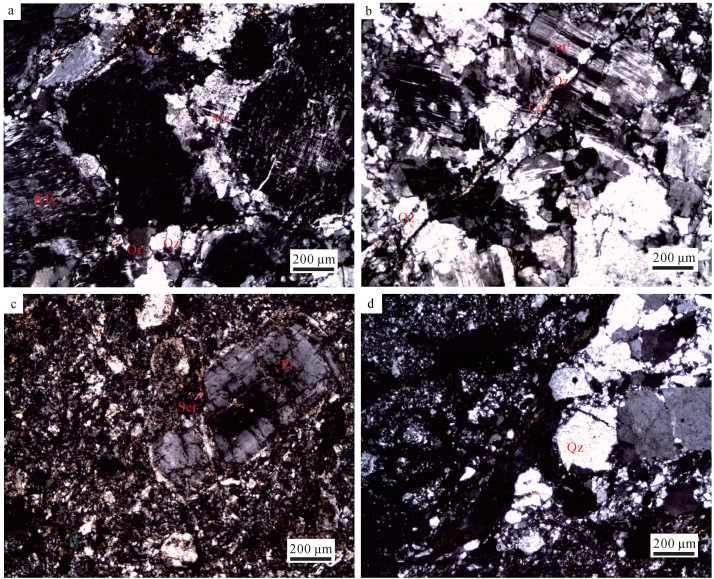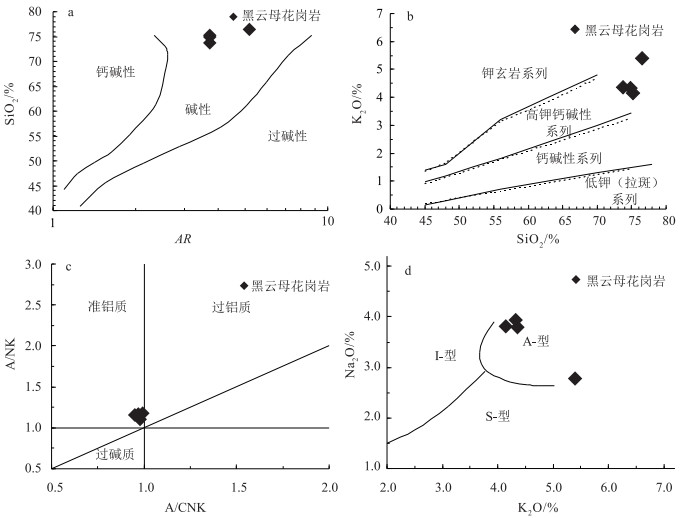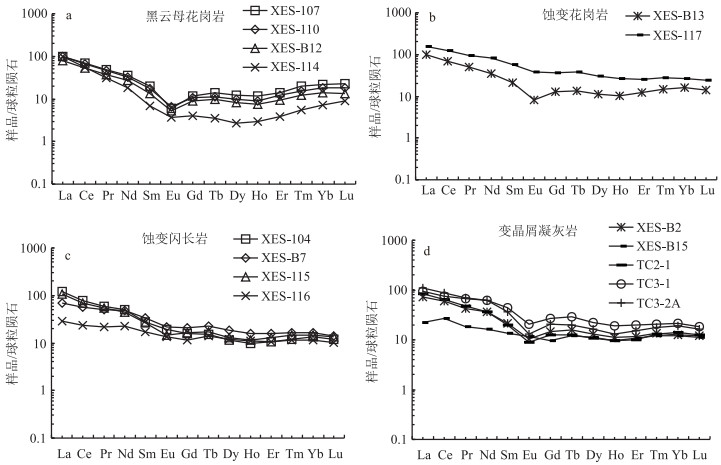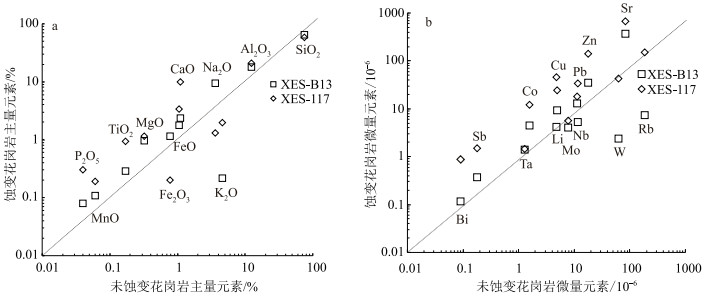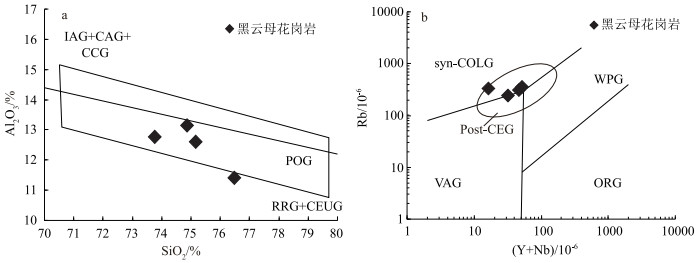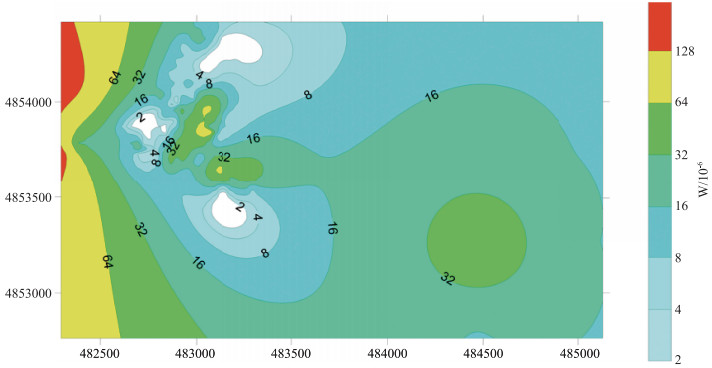Geochemistry and ore-search prospect analysis of the Xiaojiashan tungsten metallogenic rock mass in Barkol area, Xinjiang
-
摘要:
小加山钨矿床位于新疆东准噶尔成矿区,侵入岩主要岩石类型为黑云母花岗岩,赋矿围岩主要为蚀变闪长岩和变晶屑凝灰岩。对侵入岩及其围岩主量、微量和稀土元素的地球化学特征进行分析,充分认识侵入岩浆的性质、成矿物质来源及构造背景。花岗岩蚀变过程中钾长石大量分解,W元素在热液作用下由花岗岩进入矿脉,使蚀变围岩中W含量降低。黑云母花岗岩是晚古生代海西期岩浆活动的产物。该矿床构造背景是后碰撞伸展花岗岩,岩体形成于伸展构造环境。在海西期构造活动影响下含钨花岗质岩浆侵入地层,富含W元素岩浆过渡性流体沿裂隙向上流动,在上部地层中引发硅化和绢云母化。随着大气降水的加入,成矿流体温度降低,成矿物质与石英沉淀形成石英脉型钨矿床。结合矿化富集规律、控矿断裂构造,以及异常带区域W含量等值线,分析认为矿区西部外围、深部的成矿潜力大。
Abstract:Xiaojiashan tungsten deposit is located in East Junggar metallogenic area of Xinjiang and biotite granite is the most widely distributed intrusive rock mass, with alteration diorite and metamorphic crystal tuff being the mainly surrounding rocks.Systematic analyses on geochemical features from major elements, trace elements and rare earth of intrusive rocks and surrounding rock mass in Xiaojiashan reveal nature of faults, sources of ore-forming materials and tectonic settings of intrusive rocks.In the course of alteration, potassium feldspar was decomposed and elements such as W migrated into the vein through granite under the hydrothermal process, making the content of tungsten lower gradually in the alteration of surrounding rocks.The biotite granite is the product of magmatic activities in Hercynian period of Late Paleozoic.Tectonic settings of the deposit are post-collisional extensional granite, and the rocks were formed in an extensional tectonic environment.Under the influence of Hercynian tectonic activities, tungsten-containing granitic magma invaded strata, and magmatic hydrothermal transitional fluid, which was rich in tungsten and flowed upward along the fissure, causing silicification and sericitization in the upper strata.With the increase of atmospheric precipitation, ore-forming fluid temperature was reduced and the ore-forming materials and quartz precipitation formed the quartz vein type tungsten deposit.Combined with the law of mineralization enrichment, ore-controlling fault structures and W content contour lines in anomalous zone, the metallogenic potential in the western periphery and deep part of the mining area was analyzed.
-
致谢: 岩石地球化学测试得到核工业北京地质研究院的帮助,审稿专家提出了宝贵意见,在此一并表示衷心的感谢。
-
图 1 小加山钨矿区位置(a)、地质平面略图(b)和地质简图(c)①
1—第四系;2—中泥盆统大南湖组第一亚组第二岩性段;3—第一亚组第一岩性段;4—片麻状石英闪长岩;5—黑云母花岗岩;6—钾长花岗岩;7—中泥盆统大南湖组第二亚组;8—地质界线;9—含矿石英细脉带;10—断层;11—背斜轴;12—W矿化异常曲线(2.8×10-6);13—Mo矿化异常曲线(1.5×10-6);14—矿化异常带;Ⅰ—1号矿化异常带;Ⅱ—2号矿化异常带;F1—测区北部断裂;F2—测区南部断裂
Figure 1. Location (a) and geological sketch map (b, c) of Xiaojiashan tungsten deposit
图 8 小加山花岗岩主量元素SiO2-Al2O3(a)[45]和微量元素(Y+Nb)-Rb(b)构造环境判别图解[47]
IAG—岛弧花岗岩类;CAG—大陆弧花岗岩类;CCG—大陆碰撞花岗岩类;POG—后造山花岗岩类;RRG—与裂谷有关的花岗岩类;CEUG—与大陆造陆抬升有关的花岗岩类;syn-COLD—同碰撞花岗岩;VAG—火山弧花岗岩;WPG—板内花岗岩;ORG—洋中脊花岗岩;Post-CEG—后碰撞伸展花岗岩
Figure 8. Discriminations of major elements (a) and trace elements of structural environments of granite in Xiaojiashan
表 1 小加山钨矿区岩体主量元素分析结果
Table 1 Analyses of major elements of rocks in the Xiaojiashan tungsten deposit
% 元素 XES-104 XES-107 XES-110 XES-B2 XES-B7 XES-B12 XES-B13 XES-B15 XES-114 XES-115 XES-116 XES-117 TC2-1 TC3-1 TC3-2A SiO2 65.19 73.76 74.86 71.64 53.26 75.17 65.25 77.59 76.48 57.73 47.91 57.93 73.90 68.49 64.36 Al2O3 16.79 12.77 13.16 11.96 17.66 12.61 17.70 9.94 11.41 17.22 16.88 21.05 13.56 15.04 17.72 Fe2O3 1.91 0.57 0.80 0.52 2.27 0.17 1.14 0.66 1.52 2.55 4.01 0.20 0.22 0.91 1.15 MgO 0.92 0.36 0.36 1.70 3.71 0.38 0.95 0.66 0.19 3.00 7.33 1.14 0.39 1.09 1.43 CaO 3.42 1.38 1.15 1.91 4.26 1.22 2.36 1.48 0.64 5.92 10.69 9.87 1.56 2.38 1.31 Na2O 4.45 3.80 3.93 3.95 3.87 3.82 9.39 3.71 2.78 5.82 3.30 1.31 3.75 5.08 0.61 K2O 3.50 4.36 4.33 1.54 1.77 4.15 0.22 1.33 5.39 1.42 0.79 1.98 4.79 1.40 6.14 MnO 0.17 0.06 0.06 0.04 0.13 0.06 0.11 0.07 0.06 0.54 0.19 0.19 0.06 0.10 0.05 TiO2 0.36 0.17 0.19 0.54 1.26 0.18 0.29 0.45 0.14 0.74 1.00 0.93 0.21 0.66 0.77 P2O5 0.20 0.04 0.05 0.06 0.35 0.04 0.08 0.10 0.02 0.37 0.21 0.30 0.06 0.18 0.11 烧失量 0.74 1.86 0.42 2.15 4.58 0.72 0.73 1.13 0.40 0.56 1.20 1.59 0.42 0.74 3.39 FeO 2.35 0.94 0.75 3.82 6.58 1.48 1.77 2.77 1.01 3.95 6.21 3.42 1.10 3.76 2.90 总量 100.00 100.06 100.06 99.82 99.70 100.00 99.98 99.88 100.04 99.82 99.72 99.91 100.03 99.82 99.95 注:XES-104、XES-B7、XES-115和XES-116为蚀变闪长岩;XES-107、XES-110、XES-B12和XES-114为黑云母花岗岩;XES-B13和XES-117为蚀变花岗岩;XES-B2、XES-B15、TC2-1、TC3-1和TC3-2A为变晶屑凝灰岩;数据由核工业北京地质研究院测试 表 2 小加山钨矿区黑云母花岗岩岩石化学参数
Table 2 Geochemical parameters of biotite granite in the Xiaojiashan tungsten deposit
样品编号 A/CNK A/NK SI AR 碱值 FL MF XES-107 0.95 1.16 3.57 3.72 0.64 85.50 80.82 XES-110 0.99 1.18 3.53 3.72 0.63 87.75 81.19 XES-B12 0.97 1.17 3.77 3.72 0.63 86.70 81.4 XES-114 0.98 1.10 1.76 5.20 0.72 92.70 92.97 注:A/CNK-铝饱和指数,A/CNK=Al2O3/(CaO+Na2O+K2O);A/NK-摩尔分数比,A/NK=Al2O3/(Na2O+K2O)(摩尔分数比);SI为固结指数,SI=100×MgO/(MgO+Fe2O3+FeO+Na2O+K2O(%);AR为碱度率,AR=[Al2O3+CaO+(Na2O+K2O)]/[Al2O3+CaO-(Na2O+K2O)](%),当SiO2>50%,K2O/Na2O大于1而小于2.5时,Na2O+K2O=2Na2O;碱值=(Na2O+K2O)/Al2O3(%);FL为长英指数,FL=100×(Na2O+K2O)/ (CaO+Na2O+K2O) (%);MF为镁铁指数,MF=100×(Fe2O3+FeO)/(MgO+Fe2O3+FeO) (%) 表 3 小加山钨矿床岩石稀土和微量元素分析结果
Table 3 Analyses of REE and trace elements of rocks in the Xiaojiashan tungsten deposit
元素 XES-104 XES-107 XES-110 XES-B2 XES-B7 XES-B12 XES-B13 XES-B15 XES-114 XES-115 XES-116 XES-117 TC2-1 TC3-1 TC3-2A La 37.2 30.7 30.2 22.3 21.3 24.8 31.2 6.93 30.5 33.9 8.85 47.8 26.1 28.8 34 Ce 63 56.1 53.8 47.5 46.6 43.1 54.7 21.9 45.1 54.9 18.7 98.2 51.9 61.9 69.8 Pr 7.31 5.93 5.61 5.19 6.18 4.55 5.99 2.21 3.77 6.58 2.64 11.7 5.81 8.19 8.65 Nd 30.4 21.7 19.5 21.9 29 16.4 21.2 9.74 11 27 13.6 50.1 21.8 37.5 37 Sm 5.37 3.83 3.46 4.24 6.65 2.62 4.05 2.67 1.31 5.11 3.38 11.1 3.87 8.51 7 Eu 1.41 0.45 0.48 0.753 1.58 0.379 0.588 0.84 0.274 1.08 0.984 2.85 0.646 1.52 0.956 Gd 4.03 3.08 2.75 3.83 5.4 2.36 3.25 2.54 1.06 4.29 3 9.55 3.22 6.94 5.32 Tb 0.718 0.656 0.533 0.75 1.07 0.464 0.649 0.579 0.167 0.803 0.669 1.84 0.592 1.38 0.948 Dy 3.68 4 3.11 4.2 5.93 2.64 3.68 3.66 0.857 4.18 3.83 10 3.43 7.24 5.32 Ho 0.716 0.828 0.652 0.82 1.13 0.539 0.741 0.699 0.213 0.841 0.806 1.88 0.701 1.37 0.94 Er 2.27 2.92 2.56 2.44 3.34 1.94 2.59 2.28 0.815 2.69 2.21 5.39 2.12 4.16 3.14 Tm 0.393 0.632 0.505 0.44 0.534 0.392 0.484 0.397 0.179 0.468 0.378 0.897 0.421 0.672 0.577 Yb 2.78 4.49 3.75 2.67 3.41 2.92 3.32 2.57 1.51 3.09 2.42 5.63 2.99 4.41 4.03 Lu 0.4 0.743 0.612 0.394 0.466 0.452 0.477 0.376 0.293 0.452 0.338 0.787 0.418 0.601 0.554 Y 21.5 27.9 23.4 23.4 32.3 18.6 23.2 21 7.51 25.4 20.7 51 21 37.2 26.9 Li 15.3 7.55 6.09 17.2 29.2 3.07 4.22 36.7 2.54 19.9 21.2 45.6 5.15 70.3 668 Be 1.74 3.46 4.47 1.37 1.24 1.76 6.84 4.78 1.5 5.01 0.73 9.21 1.8 2.53 75.8 Sc 3.57 2.79 2.95 13.2 19.6 2.34 3.39 6.69 1.84 12.9 35.8 21.3 2.38 13.6 16.9 V 18.3 9.6 13 67.4 177 13.1 16.9 40.4 17.7 124 259 85 20.5 55.7 62.9 Cr 6.43 7.02 5.54 15.5 6.13 3.13 2.37 11.7 4.67 4.18 42.1 35 46.5 19.2 10.6 Co 2.55 1.47 1.41 9.92 26.6 1.76 4.54 8.41 1.6 9.08 38.2 12.1 1.59 8.15 4.26 Ni 3.74 2.81 5.03 30.5 12.7 3.1 9.09 9.51 2.38 9.54 51.3 17 6.9 11.1 8.21 Cu 8.94 2.81 4.6 16.9 29.7 6.49 9.33 28.5 5.79 8.98 91.1 24 6.1 25.4 52 Zn 69.6 16.5 19.6 54.7 100 17.5 35.3 55.8 17.5 68.2 83.6 143 17.3 68.7 50.3 Ga 17.1 14.6 16.6 13.2 17.9 12.2 19.2 9.17 13.5 19 16.3 28.1 13.5 18.2 39.5 Rb 99.1 211 186 35.2 68.2 144 7.37 93.2 200 71.2 38.5 150 147 123 122 Sr 434 95 102 310 404 85.1 366 217 47.8 449 386 666 190 372 47.5 Mo 5.14 20.2 3.16 1.76 1.6 5 4.07 4.45 2.41 3.54 3.98 5.56 7.76 4.36 11.2 Cd 0.344 0.267 0.195 0.24 0.304 0.2 0.216 0.14 0.151 0.237 0.208 0.382 0.21 0.241 0.358 In 0.041 0.012 0.014 0.061 0.041 0.008 0.027 0.048 0.007 0.081 0.06 0.285 0.019 0.101 1.32 Sb 0.269 0.137 0.234 0.226 1.67 0.214 0.367 0.417 0.143 0.168 0.244 1.48 0.17 0.663 2.62 Cs 2.59 2.1 1.77 1.14 4.18 1 0.833 5.48 1.82 2.39 2.33 18.1 1.99 41.4 64 Ba 1343 285 271 389 846 224 60.2 187 129 172 193 248 555 313 659 W 3.46 247 2.62 1.13 1.2 0.856 2.4 210 2.63 4.33 0.953 42.5 65.7 2.87 107 Tl 0.505 0.71 0.687 0.286 0.507 0.513 0.059 1.65 0.794 0.282 0.197 2.14 0.558 1.94 4.7 Pb 24.9 12.2 13.6 4.87 22.8 10.3 5.3 7.33 10.9 7.81 9.42 33.4 10.5 12.3 4.61 Bi 0.265 0.104 0.203 0.034 0.05 0.037 0.115 1.06 0.032 0.144 0.063 0.894 0.104 0.401 26.3 Th 8.32 27.7 26.3 7.74 4.65 23.6 22.7 5.19 27.5 6.3 2.1 12.8 20 8.41 8.67 U 2.31 2.62 2.04 2.07 1.75 1.73 5.6 1.6 1.22 4.31 0.798 2.91 2.33 2.33 3.65 Nb 7.59 15.7 15.3 8.2 6.2 8.78 13 6.74 5.84 9.34 2.05 18.2 8.44 12.1 11 Ta 0.572 1.68 1.63 0.629 0.42 0.996 1.39 0.503 0.799 0.557 0.135 1.46 0.956 0.917 0.781 Zr 351 132 120 156 240 103 190 168 61.7 142 68.9 413 118 289 293 Hf 6.91 5.25 4.72 4.12 5.74 3.67 5.58 4.54 2.66 4.03 2.04 11.2 3.78 7.56 8.03 ΣREE 455.67 405.96 371.52 346.67 421.29 300.09 387.06 198.78 252.58 430.99 219.49 787.75 356.34 540.69 516.42 LREE 355.28 279.00 266.76 241.75 280.97 216.56 281.54 108.93 213.88 317.13 126.72 550.83 261.02 363.46 377.54 HREE 100.40 126.96 104.75 104.92 140.32 83.53 105.51 89.86 38.70 113.85 92.77 236.93 95.32 177.23 138.88 LREE/HREE 3.54 2.20 2.55 2.30 2.00 2.59 2.67 1.21 5.53 2.79 1.37 2.32 2.74 2.05 2.72 (La/Yb)N 9.02 4.61 5.43 5.63 4.21 5.73 6.34 1.82 13.62 7.40 2.47 5.72 5.89 4.40 5.69 δEu 0.89 0.39 0.46 0.56 0.78 0.46 0.48 0.97 0.69 0.69 0.93 0.83 0.54 0.59 0.46 δCe 0.87 0.94 0.93 1.03 0.97 0.91 0.90 1.34 0.86 0.83 0.92 0.97 0.97 0.96 0.96 注:XES-104、XES-B7、XES-115和XES-116为蚀变闪长岩;XES-107、XES-110、XES-B12和XES-114为黑云母花岗岩;XES-B13和XES-117为蚀变花岗岩;XES-B2、XES-B15、TC2-1、TC3-1和TC3-2A为变晶屑凝灰岩;数据由核工业北京地质研究院测试;稀土和微量元素含量单位为10-6 -
楼法生, 唐春花.新疆巴里坤红井子地区石炭纪火山岩及其大地构造环境分析[J].新疆地质, 1995, 13(1):67-75. http://www.cnki.com.cn/Article/CJFDTotal-XJDI501.006.htm 姜晓.新疆巴里坤红井子南铅锌矿找矿前景分析[J].新疆有色金属, 2018, 41(3):5-8. http://www.wanfangdata.com.cn/details/detail.do?_type=perio&id=xjysjs201803003 程富强, 张广威, 刘峰, 等.新疆巴里坤县红井子南铅锌矿地质特征[J].黑龙江科技信息, 2011, (20):247. http://www.wanfangdata.com.cn/details/detail.do?_type=perio&id=hljkjxx201120246 王伟健.新疆巴里坤县大加山一带碱性花岗岩的特征及构造环境探讨[J].新疆地质, 1996, 14(2):159-169. http://www.cnki.com.cn/article/cjfd1996-xjdi602.007.htm 毛启贵, 肖文交, 韩春明, 等.东准噶尔地区晚古生代向南增生:来自A型花岗岩的启示[J].岩石学报, 2008, 24(4):733-742. http://www.cnki.com.cn/Article/CJFDTotal-YSXB200804013.htm 杨志平.新疆巴里坤县八墙子一带金铜成矿规律分析及找矿方向[J].华北国土资源, 2011, (2):4-6. http://www.wanfangdata.com.cn/details/detail.do?_type=perio&id=hbgtzy201102002 赵同阳, 陈朝忠, 姜杰岩, 等.新疆巴里坤县八墙子一带金、铜成矿规律分析及找矿方向[J].西北地质, 2011, 44(1):20-27. http://www.wanfangdata.com.cn/details/detail.do?_type=perio&id=xbdz201101003 周兵, 匡爱兵, 叶征宇, 等.新疆东天山八墙子地区地球化学特征及找矿预测[J].地球科学进展, 2012, 27(S1):315-320. http://www.wanfangdata.com.cn/details/detail.do?_type=perio&id=7956058 赵云雷, 金辉, 侯四周, 等.新疆巴里坤小加山钼钨矿床水工环地质特征对矿山开发的影响[J].中国钼业, 2015, 39(4):23-26. http://www.wanfangdata.com.cn/details/detail.do?_type=perio&id=zgmy201504005 屈翠侠, 易鹏飞, 杨兴科, 等.新疆巴里坤塔格柳树沟组玄武岩成因及其构造环境——岩石地球化学及Sr-Nd-Pb同位素证据[J].西北地质, 2015, 48(3):214-225. http://www.wanfangdata.com.cn/details/detail.do?_type=perio&id=xbdz201503023 屈翠侠, 杨兴科, 易鹏飞, 等.巴里坤塔格晚古生代侵入岩岩石地球化学与Sr-Nd-Pb同位素特征[J].西北地质, 2015, 48(2):17-30. http://www.cnki.com.cn/Article/CJFDTotal-XBDI201502003.htm 崔方磊, 汪晓伟, 徐学义, 等.东天山七角井-巴里坤地区辉绿岩脉年代学及岩石成因[J].西北地质, 2015, 48(2):43-56. http://www.wanfangdata.com.cn/details/detail.do?_type=perio&id=xbdz201502005 沙鑫, 汪立今, 宋来忠, 等.新疆巴里坤膨润土矿晚古生代哈尔加乌组安山岩地球化学特征及成因分析[J].矿物岩石地球化学通报, 2013, 32(6):769-773. http://www.wanfangdata.com.cn/details/detail.do?_type=perio&id=kwysdqhxtb201306012 王来兴.新疆北部巴里坤塔格一带早二叠世基性侵入岩特征[J].世界有色金属, 2018, (1):291-292. http://www.wanfangdata.com.cn/details/detail.do?_type=perio&id=sjysjs201801175 郭晓俊, 张成立, 李雷, 等.新疆巴里坤地区志留纪花岗岩的确定及其地质意义[J].地质科学, 2013, 48(4):1050-1068. http://www.wanfangdata.com.cn/details/detail.do?_type=perio&id=dzkx201304007 魏新昌, 王德贵, 陈琪乐, 等.巴里坤下涝坝一带超基性岩特征及地质意义[J].新疆地质, 2012, 30(S1):20-24. http://www.wanfangdata.com.cn/details/detail.do?_type=perio&id=xjdz2012z1006 李娟, 王德贵.巴里坤下涝坝一带辉长岩锆石SHRIMP U-Pb定年及地质意义[J].新疆地质, 2012, 30(S1):17-19. http://www.cnki.com.cn/Article/CJFDTotal-XJDI2012S1007.htm 马晓鸣, 何登发, 李涤, 等.巴里坤盆地晚古生代火山岩年代学及构造演化[J].地质科学, 2011, 46(3):798-807. http://www.wanfangdata.com.cn/details/detail.do?_type=perio&id=dzkx201103015 唐玉山.新疆巴里坤双峰山浅成低温热液金矿床的地质特征与成矿模式[J].新疆有色金属, 2009, 32(S1):79-81+83. http://www.wanfangdata.com.cn/details/detail.do?_type=perio&id=xjysjs2009z1031 汪立今, 宋来忠, 张娜, 等.新疆巴里坤膨润土矿的矿物学及地质特征研究[J].矿物学报, 2006, (1):69-72. http://www.wanfangdata.com.cn/details/detail.do?_type=perio&id=kwxb200601012 马雪, 冯成贵, 虞卫东, 等.新疆巴里坤县三塘湖北卡拉岗组火山岩特征[J].新疆地质, 2005, (3):234-238. http://www.wanfangdata.com.cn/details/detail.do?_type=perio&id=xjdz200503005 谢群林.新疆巴里坤县双峰山金矿床地质特征及控矿因素分析[J].新疆有色金属, 2002, (2):16-18. http://www.wanfangdata.com.cn/details/detail.do?_type=perio&id=xjysjs200202005 王军, 刘鹏宇.新疆巴里坤县老爷庙金矿地质特征及找矿方向探讨[J].东华理工大学学报(自然科学版), 2016, 39(2):150-155. http://www.wanfangdata.com.cn/details/detail.do?_type=perio&id=hddzxyxb201602008 龙立学, 曾凡淼, 黄迅, 等.新疆巴里坤红石滩铜矿床石英闪长斑岩LA-ICP-MS锆石U-Pb年龄及其地质意义[J].资源调查与环境, 2014, 35(1):53-60. http://www.wanfangdata.com.cn/details/detail.do?_type=perio&id=hsdzykc201401007 揣立刚.新疆巴里坤县小瑞江铜多金属矿地质-地球物理综合特征分析[J].新疆有色金属, 2012, 35(5):36-39+41. http://www.wanfangdata.com.cn/details/detail.do?_type=perio&id=xjysjs201205017 宋冬梅.新疆巴里坤县大红山铜金矿床地质特征[J].西部探矿工程, 2015, 27(7):100-102. http://www.wanfangdata.com.cn/details/detail.do?_type=perio&id=xbtkgc201507033 李平, 朱志新, 陈川, 等.新疆巴里坤索尔巴斯陶金矿床成矿流体特征及矿床成因[J].矿床地质, 2014, 33(2):339-349. http://www.wanfangdata.com.cn/details/detail.do?_type=perio&id=kcdz201402007 王彦军, 赵雪晶, 吴新忠, 等.新疆巴里坤县索尔巴斯陶金矿床地质特征及矿床成因探讨[J].西北地质, 2018, 51(2):171-177. http://www.wanfangdata.com.cn/details/detail.do?_type=perio&id=xbdz201802022 曾凡淼, 廖辉宝.新疆巴里坤县红石滩铜矿地质特征及成因探讨[J].世界有色金属, 2018, (21):181-183. http://www.wanfangdata.com.cn/details/detail.do?_type=perio&id=sjysjs201821106 宁勇.探讨新疆巴里坤小瑞江铜矿地质特征及矿床成因[J].世界有色金属, 2017, (21):246-247. https://kns.cnki.net/KCMS/detail/detail.aspx?dbcode=CJFD&filename=COLO201721147 李挺.新疆巴里坤县某铜矿地质特征及找矿标志[J].世界有色金属, 2019, (9):65-66. http://www.wanfangdata.com.cn/details/detail.do?_type=perio&id=sjysjs201909041 王有平, 李万平.物探成果在新疆巴里坤县结勒喀腊一带金多金属矿勘查中的应用[J].世界有色金属, 2019, (24):141-142. http://www.wanfangdata.com.cn/details/detail.do?_type=perio&id=sjysjs201924081 周云飞, 徐九华, 单立华, 等.新疆巴里坤小加山钨矿地质特征与成因[J].地质通报, 2016, 35(12):2121-2132. http://www.wanfangdata.com.cn/details/detail.do?_type=perio&id=zgqydz201612020 新疆维吾尔自治区地质矿产局.新疆维吾尔自治区区域地质志[M].北京:地质出版社:1993. 王银喜, 顾连兴, 张遵忠, 等.博格达裂谷双峰式火山岩地质年代学与Nd-Sr-Pb同位素地球化学特征[J].岩石学报, 2006, 22(5):1215-1224. http://www.wanfangdata.com.cn/details/detail.do?_type=perio&id=ysxb98200605013 方国庆.东天山古生代板块构造特点及其演化模式[J].甘肃地质学报, 1994, 3(1):34-40. http://www.wanfangdata.com.cn/details/detail.do?_type=perio&id=QK199400812506 李锦轶, 宋彪, 王克卓, 等.东天山吐哈盆地南缘二叠纪幔源岩浆杂岩:中亚地区陆壳垂向生长的地质记录[J].地球学报, 2006, 27(5):424-446. http://www.cnki.com.cn/Article/CJFDTotal-DQXB200605006.htm 王玉玺.新疆博格达山东段晚古生代水系沉积物及成矿意义的研究[D].兰州大学硕士学位论文, 2010. 顾连兴, 胡受奚, 于春水, 等.论博格达俯冲撕裂型裂谷的形成与演化[J].岩石学报, 2001, 17(4):585-597. http://www.wanfangdata.com.cn/details/detail.do?_type=perio&id=ysxb98200104009 孙桂华.新疆哈尔里克山古生代以来构造变形及构造演化[D].中国地质科学院地质研究所博士学位论文, 2007. 李冰, 杨红霞, 刘崴, 等.硅酸盐岩石化学分析方法(GB/T14506.1-GB/T14506.30-2010)[M].国家地质实验测试中心, 2010. Taylor S R, Mclennan S M.The continental Crust:its composition and evolution.London[M].Blackwell, 1985:57-72.
Wright J B.A simple alkalinity ratio and its application to questions of non-orogenic granite genesis[J].Geol.Mag., 1969, 106:370-384. http://www.wanfangdata.com.cn/details/detail.do?_type=perio&id=GEO106_04\GEO\GEO106_04\S0016756800058222h.xml
Peccerillo A.Geochemistry of Ecocene calc-alkaline volcanic rocks from the Kastamenu area Northern Turkey[J].Contrib.Miner.Petrol., 1976, 58(1):63-81. doi: 10.1007/BF00384745
Mania P D, Piccoli P M.Tectonic discrimination of granitoids[J].Geological Society of America Bulletin, 1989, 101:635-643. https://www.researchgate.net/publication/279908588_Tectonic_discrimination_of_granitoid
Collins W J.Nature and origin of A type granites with paticular reference to Southeastern Australia.Contrib[J].Miner.Petro., 1982, 80:189-200. doi: 10.1007/BF00374895
Pearce J A.Source and setting of granitic rocks[J].Episodes, 1996, 19:120-125. https://www.researchgate.net/profile/Julian_Pearce2/publication/262099137_Sources_and_Settings_of_Granitic_Rocks/links/0deec536a205fab85a000000/Sources-and-Settings-of-Granitic-Rocks.pdf
Forster H J, Tischendorf G, Trumbull R B.An evaluation of Rb vs.(Y+Nb) discrimination diagram to infer tectonic setting of silicie igneous rocks[J].Lithos, 1997, 40:261-293. https://www.sciencedirect.com/science/article/abs/pii/S0024493797000327
孙桂华, 李锦轶, 高立明, 等.新疆东部哈尔里克山闪长岩体锆石SHRIMP U-Pb定年及其地质意义[J].地质论评, 2005, 51(4):463-469. http://www.cnki.com.cn/Article/CJFDTotal-DZLP200504018.htm 陈希节, 舒良树.新疆哈尔里克山后碰撞期构造-岩浆活动特征及年代学证据[J].岩石学报, 2010, 26(10):3057-3064. http://www.wanfangdata.com.cn/details/detail.do?_type=perio&id=ysxb98201010017 汪传胜, 顾连兴, 张遵忠, 等.新疆哈尔里克山二叠纪碱性花岗岩-石英正长岩组合的成因及其构造意义[J].岩石学报, 2009, 25(12):3182-3196. http://www.wanfangdata.com.cn/details/detail.do?_type=perio&id=ysxb98200912007 中色地科矿产勘查股份有限公司内部资料.2013.




 下载:
下载:
